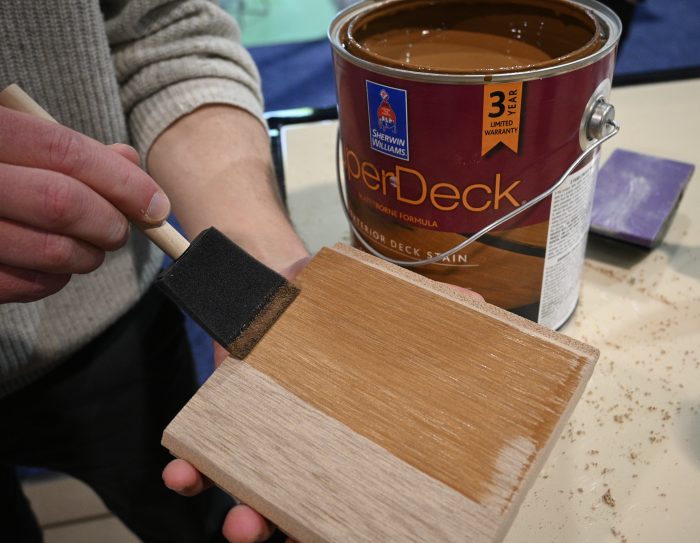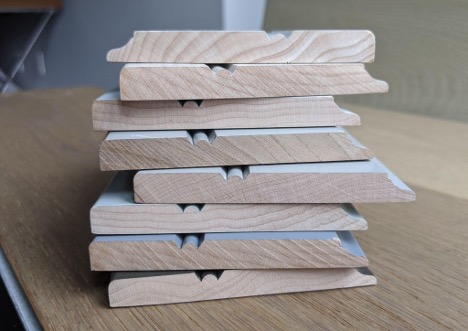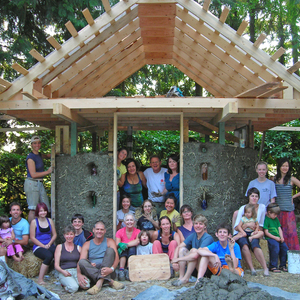
The Great Wall of China embodies the enduring muscle of ancient building techniques—surviving centuries through earthquakes, wind, and rain. Sticky rice was a key ingredient; it was combined with slaked lime to make a mortar of greater strength and moisture resistance than sand, lime, and water alone. Fast-forward 35 centuries, and we find a growing range of bio-based building products touting properties that promise longevity. For example, Modern Mill—a manufacturing company based in Fernwood, Mississippi—has patented ACRE, a sustainable wood-alternative material made from rice husks. The zero-waste facility partners with distributors throughout the U.S. to supply dimensional lumber, sheet goods, boards, decking, and siding.
If you have seen rice fields, you know the grain (Oryza sativa) grows in water. We eat the seed kernel, and the husk keeps it dry. Hence the value of discarded rice husks (also called hulls) as a naturally hydrophobic building material. Husks contain a high silica content used as an amendment to improve Portland cement and produce rice concrete; it is also used for making geopolymers, ceramic glazes, class A thermal insulation, particle boards, and now Modern Mill’s ACRE line.

Why rice hulls?
According to Chandler Delink, national sales manager for Moder Mill, the inspiration to make rice hull products came from polymer-husk technology developed in Germany to replace tropical hardwoods in the furniture industry. Processing discarded rice hulls into densified material is a growing trend, helping reduce the consumption of forestry resources. Unlike wood pulp, hulls will not absorb moisture, yielding a biomass product with the characteristics of PVC—waterproof, flexible, and lightweight. But it will accept tooling, such as drilling, routering, and mitering. (On Modern Mill’s website, you will find installation literature and videos illustrating these capacities.)
Performance claims
According to Chandler, the material has a thermal expansion coefficient but “25% less than vinyl and PVC siding.” Natural Homes published a paper by Paul A. Oliver, Ph.D. on The Rice Hull House in Tennessee. He states that ASTM testing “reveals that rice hulls do not flame or smolder very easily, they are highly resistant to moisture penetration and fungal decomposition, they do not transfer heat very well, they do not smell or emit gases, and they are not corrosive to aluminum, copper or steel.” The author goes into great depth on the virtues of husks as a material aggregate.

Listing the virtues of ACRE siding, Chandler emphasizes the contrasts with popular competitors, saying it’s more rigid than PVC but more flexible than fiber cement—one person can carry a 16-ft. board without it breaking. Other named attributes include: cutting the material produces almost no dust and does not cling to clothing (PVC has a charge like static electricity that makes it sticky); the material will not melt even when cut with a dull blade; it has no toxic gasses or friable minerals; it can take conventional wood stains; and, for making curves, it will mold when heated.

Pick up a piece of ACRE, and you notice a slightly rough texture. Since the siding and trims are manufactured by milling from large sheets, the edges are sharper than those of extruded siding and trim. It has a distinctly wood-like appearance and feel. For this reason alone, you may want to consider using it. As a material made with upcycled ingredients, it also has the advantage of green bonafides for LEED and other green rating programs. To learn more on this front, Modern Mill includes a LEED Fact Sheet and Technical Data on their website.
Modern Mill obtains all its husks from Mississippi, and its products are available nationally through supply houses and lumber yards. Their website has a list of outlets by state. In Texas, I found distributors in Austin and San Antonio. Menards carries ACRE trims ($26.69 for 1x6x8) and sheets ($62 for 4×8). Modern Mill will also sell direct.
________________________________________________________________________
Fernando Pagés Ruiz is a builder and an ICC-certified residential building inspector active in code development.
Weekly Newsletter
Get building science and energy efficiency advice, plus special offers, in your inbox.















10 Comments
This looks like a promising product!
The coefficient of thermal expansion seems to mirror that of wood more closely than cellular pvc. It's a factor that I would have never thought to be important until I saw gaps opening in the winter, after installing trim in the summer. It nearly rules out PVC on exteriors for me, despite the promise of rot resistance.
The other physical properties look good too. The fact that it can take paint well ought to be a major selling point.
Just ordered a sample to satisfy my curiosity; I love cool new materials.
Interesting that it doesn't generate static cling like cellular PVC, as the base resin of ACRE sounds like it's some form of PVC. Similar paint recommendations to PVC as well, with an LRV < 55%, and callouts for some of the PVC-safe paint product lines, etc.
Curious to know how the shiplap pricing compares with something like TruExterior.
It sounds like an interesting material and I'm keen to know more. Unfortunately this article reads a bit like a piece of marketing provided by the manufacturer and fails to answer basic "green building" questions.
"...ACRE, a sustainable wood-alternative material made from rice husks."
The word "sustainable" always sends up a red flag for me when it is not justified or qualified.
1. Is the rice sustainably grown? Rice hulls are NOT a waste material needing to be diverted to better uses. Best practices for rice agriculture include returning the hulls to the fields to replenish soil nutrients. Also, in many parts of the world such as California, rice is grown where it should not be, causing vast diversions of water through massive, unsustainable irrigation systems.
2. What type of plastic is being used as the resin? The article doesn't state it and I scoured the manufacturer's website and failed to find that information either.
In the future please show a reasonable amount of skepticism when manufacturers' claims of sustainability are not accompanied by detailed support. One of the reasons I read articles like this is because I expect the authors to have done at least some of the research I would otherwise have to do. It's nice to be made aware of a new product. But advertising can do that. I hope to see more when I read an article or blog post. Thanks.
I can answer the 2nd question.
I got a followup call from a sales rep after I ordered the samples, and asked about the resin matrix after making some educated guesses from the website. The resin is a PVC formulation. The rep also mentioned that most standard PVC adhesives can be used for joining.
I didn't specifically ask if the PVC was derived from bio-based feedstocks, and I don't remember if the rep mentioned.
It's strange the the CTE (coeff of therm exp) is only 25% lower than unfilled PVC, but not too surprising if the rice hulls are processed to a short fiber length as a bulk filler, and if the fiber volume fraction isn't really high. Depends on the resin formulation too...
Thank you.
Hi, good folks. I'm posting on Fernando's behalf, as we are having some technical difficulties and he is unable to respond but wants to say the following:
After posting Rice Husk Siding and Trim Board on social media, a steady stream of comments came. The first to catch my eye was Mark Clement, who wort, “I’ve used it; it’s fantastic.” And later, “It’s unlikely I’ll ever touch a piece of [ordinary] PCV again.” So, I wrote to Mark asking him to comment more on his experience with the product.
Mark was kind enough to reply and told me he had used conventional PCV trim with mixed results, “I'm about as much of a wood guy as they come, I use PVC to trim out jacked-up porch columns, exterior door trim, and various other tasks. It works, but I hate it. The dust--stringy fibers, really--sucks. It's difficult to clean off and the static charge that makes it stick to everything. Just isn't my fave,” Mark wrote in an email.
On his first experience with ACER (rice husk siding, he reported, “With Acre--53% recycled rice husks, 47% PVC, I'm told--I get all the weatherability of PVC without the headaches. And I get to use a partially recycled material which makes me feel better. One second after running it through a table saw it's obviously better than PVC. The dust is just that: Dust. It falls out of the offset chute on my table saw. No static charge. Cuts beautifully. Sands easily. It takes a router edge super sweet. It's light and floppy like PVC but doesn't break like cementitious or fly-ash products. It takes paint better than, I think, anything I've ever painted.”
He concluded the email by saying, “We used it for a giant accent wall--we wanted something very stable, no witness lines or gaps to open during heating/cooling changes--and it worked fantastically well. We ripped down 1x12 to make our strips and the edges cleaned-up beautifully.”
On the other hand, Doug Horgan said, “We ran about two miles of that last year when we couldn't get alternatives. I hope it holds up. It worked and installed great, with no issues so far, but many new product failures happen a few years in, not in week one.”
Lavrans Mathiesen, a custom woodworker and expert remodeler in Seattle, liked the concept of rice-hull siding because he’s “Trying to avoid cementitious products when possible.”
Mathiesen’s comment brings me to the critique left by jollygreenshortguy, who wrote in the article comments, "’...ACRE, a sustainable wood-alternative material made from rice husks.’ The word "sustainable" always sends up a red flag for me when it is not justified or qualified.” Indeed, sustainability has become meaningless since it appears in the marketing of almost every product. ACER has a reason for the claim, which I should have developed.
Rice husks are a byproduct of rice milling that comes in huge volumes, sufficient to have become an environmental problem. The presence of lignocellulosic content, rich in silica and lignin, makes husks hydrophobic and slows the microbial degradation required to turn organic materials into fertilizer—i.e., compost. It can be used as a soil amendment at the backyard garden level but not at an industrial scale. It’s too slow. Husks cannot be used for animal feed, either, since the low sugar content provides little nutrition. By and large, husks are sent from mills to landfill, and what remains on rice fields is cleared by open burning. Given the volume of rice husk waste, researchers are trying to devise methods to turn the waste into fertilizer, but it’s not simply plowing it back into the field. Using husks for industrial processes, such as siding, is akin to reusing sawdust from lumber mills for pulp products or recycling vinyl. Not a perfect solution to a huge rice husk waste problem, but a positive step.
The PVC content is another angle that ACER could use to support its claim to sustainability. Despite using about 41% natural gas in PVC manufacture, it remains one of the building materials with the lowest global warming potential. There’s less hydrocarbon burned to create a square foot of PVC siding than a square foot of fiber cement or brick. The hydrocarbons in PVC become embodied in the material, not burned to produce it. The rice huss diverted save both landfill and open burning. Could things be better? Oh yes. For example, PVC is an easily recycled plastic. Still, recycling becomes much more difficult when you incorporate impurities, such as rice husks or minerals (some siding products contain talc).
All industrial materials have an adverse environmental impact, some more than others. Having handled ACER and heard from others using it, I still believe this siding superior to fiber cement and conventional PVC.
"PVC is an easily recycled plastic..."
This whole thing is reading like an industry sponsored greenwashing piece. Is all of the information in this article from the company press kit?
PVC is widely regarded as one of the most toxic and ecologically destructive plastics to manufacture, and PVC is certainly NOT easy to recycle. The variety of different additives used in PVC to achieve different properties, like plasticizers and rice hulls, means that mechanical PVC recycling (grinding and remelting into new products) is only practical for uniform, single-source industrial waste streams. It's highly impractical to recycle post-consumer PVCs like used building materials, because they end up being basically impossible to sort according to composition.
That leaves prohibitively expensive and energy intensive feedstock recycling, using heat and chemicals to dissolve and extract the chemical components for reuse, which currently isn't profitable. Maybe there will be more of that in the future if we pass a bunch of regulations targeting plastic waste reduction, but there is not a particularly promising political or legal landscape in the US for that to happen, so don't hold your breath.
I think pretty much everyone knows at this point that plastic recycling is practically not happening at all, with even the most recyclable PET plastics are mostly being landfilled. There is absolutely no way I would consider PVC a remotely green building material until that changes, and even then, the chlorines would make it a very hard sell when there any other alternatives.
Good information, Kiley. I know the guys you quoted and they are all top-notch builders and thinkers.
I do take issue with anything purporting that PVC is green--it is no way, no how green, no matter how hard their marketing people twist the logic. But cement boards and poly fly-ash boards are also bad.
It sounds to me like when you're stuck in a position where you have to use a synthetic, rot-resistant material, this rice hull product has advantages over the other products.
"It sounds to me like when you're stuck in a position where you have to use a synthetic, rot-resistant material, this rice hull product has advantages over the other products."
That's what I took from it.
My neighbor included a sheet of this in the middle of a deck, to have a flat surface to do pilates on, about a year ago. Aside from discoloration, it looks almost good as new, even though it's horizontal and gets rained on all the time. As for the sustainability discussion... well, good wood siding, properly cared for*, from sustainable forests, is more sustainable. But "*" rarely happens, for reasons that have nothing to do with material properties. I use cedar in personal projects and advise it to people who take care of the things they own and think of homes as homes/structures, not as investments/bling. Rice husk thing seems cool but yes, it's much harder to track environmental impact than with single-ingredient products. YMMV.
Log in or create an account to post a comment.
Sign up Log in